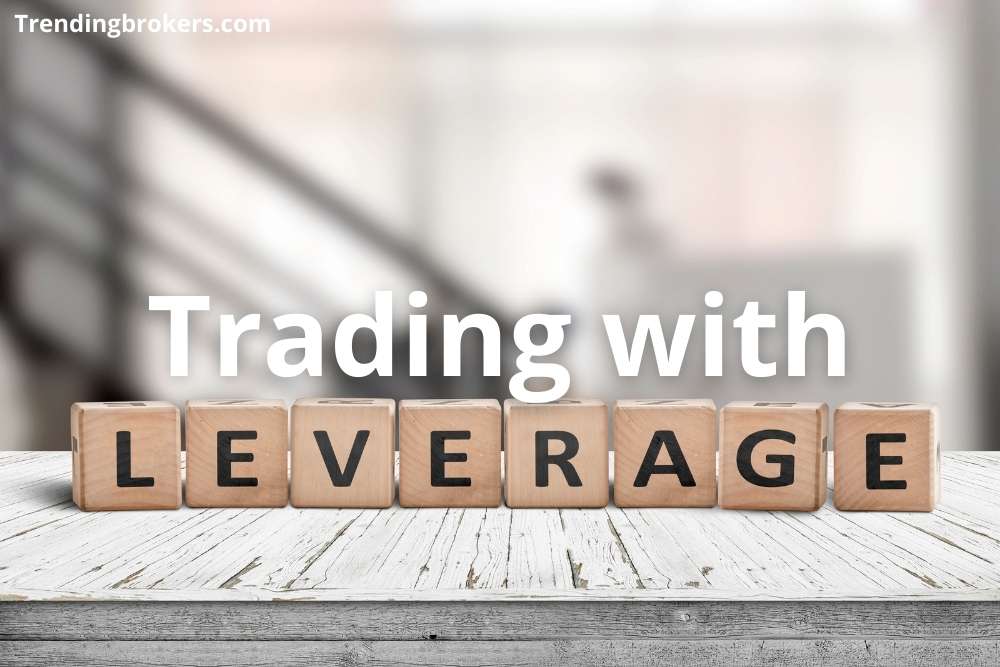Trading is the term that has attracted the young and the old since its inception. We all have been part of this trade in a small or big manner in one or the other way. It begins with a barter system of exchanging goods and, with the technical advancements, has reached a new level. Traders have electronic or digital currencies, forex trading, stocks, indices, etc., to invest and make money.
No matter what financial markets or instruments traders invest in, the new generation has everything online. Investors can have a trading account and then deposit funds to trade in the market. They have all the controls of their investments in hand and supportive tools to be experts in the trade.
The article focuses on leverage in forex trading or other markets for profitable investments. Trading with leverage is the facility that is provided by most brokers or financial instruments for opening a high market position size and having high profits. It is simple to use in the trade but requires perfect market knowledge for appropriate use.
What is Leverage?
Influence in the request moves the dealers to high trading positions, which can turn out profitable or perilous depending on dealers request understanding. A strong tool that could be used to increase request returns. It’s the loan that brokers or service providers offer so that investors can have a good trade position and if the vaccination turns out correctly.
![Trading with Leverage: Advantages and Disadvantages [2022] 1 What is Leverage?](https://trendingbrokers.com/wp-content/uploads/2022/04/What-is-Leverage.jpg)
When one needs higher profits, they have to manage the high risk of losing as well. It is called margin trading in the financial market. Allowing traders to open market positions with the brokers using small initial investments. Generally used in forex trading for making most of the market opportunities. However, traders have to be confident in their investments to make money and not lose their funds.
For example, a trader is investing in forex trading with an investment of $1000 and later finds that the market will rise. Thus, earning a good profit on the investment made, but the investor does not have funds to trade. Consequently, he uses the leverage offered by the service provider. This boosts the market position size and so the profits could be doubled.
Trading with leverage is offered in ratio, and therefore, the investor will use a 1:100 ratio. This will make the investment of $1000 to $100000. However, if trader faces a loss in the investment, they may steep lower in the market. It is highly risky for investors to trade leverage in forex or other markets.
How does Leverage work?
Trading with leverage is an attractive choice for investors, and they can have potential profits if used properly. The trading has many investors who have low capital available to them and become wealthier in a short period of time. However, this is a difficult task to use leverage appropriately. When we trade forex leverage in the market, there are chances of losing money rapidly due to the volatility and market uncertainties.
Suppose forex trading has ample opportunities and an investor is already holding a position with an initial investment of $200. He keeps monitoring the position in set intervals and when the trader finds a good market opportunity that will help them double their investments. So, the trader uses the leverage ratio as per requirements for a beneficial trade.
It works best with deposits that give traders exposure to the underlying assets. The trader initially starts in a fraction of value and provides traders with a loan for high investing. The trader gets the exposure to the margin which is termed the leverage ratio.
As a result, forex leverage or other market traders can use them for making good investments to earn profits from the same.
Types of Leveraged Products
Trading with leverage is mostly used with derivative products; generally, it takes the value of the instrument from the underlying asset without having ownership of the asset. The types of leveraged products that are mainly for the traders:
Spread Betting
Spread betting is the trading style that is allowed in the UK, usually for investing. Traders bet on the direction of the price movements of the instruments or the market. They invest in the direction that will help them earn profits. If the market gets closer to the direction chosen by the trader to invest, then the profits increase.
Unfortunately, if the same goes the other way round, then the trader will have to face the loss, which could be higher or low depending on the market factors and stop-loss set by the traders.
Read our Blog Spread Betting vs Cfd
Contracts For Difference (CFD)
CFD is the trading instrument that provides the investors with a profit from price differences of the product traded. It is a new trading instrument that has gained popularity in a short time and has wide use globally. Traders invest in the market and earn from the differences in the price of instruments at the time of purchase and sale in the market.
The opening and closing positions of the instruments are highly significant for CFD traders. They can trade forex or other markets in the CFDs and have diversified portfolios.
Other Products
The market has a long list of leveraged products from financial markets that traders can use for earning. The currency pair, shares, options, futures, ETFs, etc. All the markets or instruments of trade have their own market potential profits, and traders can use them as per their trade knowledge.
Risk Management Tools
Risk management tools are important for traders as these are necessary for managing the uncertainties and risks of the market. Forex brokers or other investor accounts lose money frequently when traded without research and analysis of the market. Investors can earn from the markets when they have key risk management tools.
Every trading instrument requires risk management and is a critical part of strategies to trade. Traders for minimizing the risks of the trade have trading tools like technical and fundamental analysis, trading platforms, advanced softwares, indicators, customer support from brokers such as Investby, charts, expert advisors, automated trading, and a long list of facilities for beneficial trading.
Traders can, other than this, have excellent market knowledge and use of leverage in forex trading and make most of their trade. A successful investment with leverage with currency pairs or CFD trading could be beneficial when traders are well prepared. Earning from the market and trading capital becomes fun when the traders do a good analysis of the trade.
This enhances their knowledge and makes profitable investments for traders.
Calculate Leverage
Leverage is calculated by the trading platforms or the calculators offering the services through the leverage trading account of the investors. They can have direct figures of trade through these or have an understanding of the calculation.
Leveraged trading is calculated with the following formula:
Leverage = Total company debt/ Shareholders equity
The traders calculate the total equity of the shareholders that is derived by multiplying the number of outstanding shares from the company’s stock price. Then total debt is divided by total equity. The result is the financial leverage ratio.
Trading capital in the market has always been an excellent source for investing when traders know the calculation properly. They can have their analysis and need not rely on the softwares alone, as these could be wrong.
Key takeaways from leverage calculation are:
- Traders should know the process
- Use it mostly with the forex market
- The trade has a risk of losing money rapidly
- Should be used in an appropriate manner
- Leverage is available in ratio form
Foreign Exchange Trading
![Trading with Leverage: Advantages and Disadvantages [2022] 2 Foreign Exchange Trading](https://trendingbrokers.com/wp-content/uploads/2022/04/Foreign-Exchange-Trading-.jpg)
Forex traders use the trading with leverage for having high market positions and invest in the market to trade. The borrowed capital is used to increase the trading position of forex traders and earn good returns. Trading in forex markets is often related to leverage as it has become a consistent part of the market.
Traders earn from the small investment in the price of currency pairs and their movements in them. The money in forex is borrowed from the brokers then has the initial margin requirements and then traded to control the money.
In forex trading or other investors calculate the margin-based leverage by dividing the transaction value from the amount of margin. Although, the margin-based leverage in forex does not have an impact on the market risk of losing money.
The forex traders or market investors open their retail investor accounts and then use the services of the brokers to trade in leverage. The forex market is huge with high liquidity, increasing the chance of risks and opportunities.
Markets other than forex that could use leverage are:
Indices
The index is the numerical form of the group performance of the particular assets, area, sector, etc. These are traded online as products that mirror their price; these include CFD trading and ETFs.
Cryptocurrencies
Cryptocurrency is the market of virtual currencies that are traded online by investors. Trading of cryptos is similar to forex trading, although it has next-generation services that protect investors from double investments, secure the trade, and have transparency.
Margin Call
Margin call in the leverage is important as this is the indicator of the low value of the investor’s account with the broker. When the value of the margin requirement for trading with leverage in forex or other markets is below then required, the broker gives the traders a margin call as notification of the requirement to amount for using leverage services.
The call occurs, the traders have to deposit the additional funds or margin-able securities and then sell the assets in the account.
Let’s Find the advantages and disadvantages of Trading with leverage:
Advantages of Leverage
Advantages of trading with leverage in the market are mentioned below:
Traders with leverage have magnified profits, traders when sure of their investments, can have the ratio. This will provide traders exposure and give them magnified profits. They can enhance their position and enjoy a handful of money from the investments.
Have ample market opportunities; traders can invest in various markets and make good investments, and trade in the market.
The shorting market is the trading style that investors can use to speculate in the markets and benefit from the rise and fall of the prices.
Traders can use the leverage 24 hours without worrying about the time limit.
Leverage is easily available with brokers and offers high returns when traded correctly.
Disadvantages of trading with leverage
Be it professional traders or beginners; all have to manage the risks of leverage when used properly to make a profit and otherwise huge loss for the investors. The drawbacks of the trading with leverage are:
- Margin calls
- Risk is high
- No privileges for traders
- Funding charges
Conclusion
Trading with leverage in the market is a good source of generating income; traders can open their retail investor accounts with brokers and then trade in the markets. The article has explored all the aspects of leverage trading and how investors can use their trading capital in a useful manner to make money. Forex leverage is the most used in the financial markets due to the opportunities, whereas other markets have less use of leverage.
However, trading in the market with leverage should be managed as the high risk of losing can impact the traders greatly. An active investor should check the market instruments and trade in the market for profitable returns.
FAQ’s
What is trading with leverage?
Leverage is the borrowed fund from the financial service providers to open in the market with high positions.
Can investors use leverage in trading CFDs?
Trading CFDs in the market with leverage is allowed; they can trade these derivative products to earn profits.


